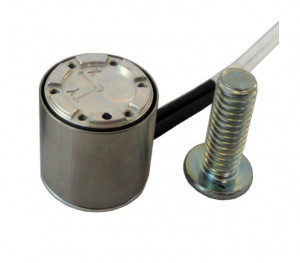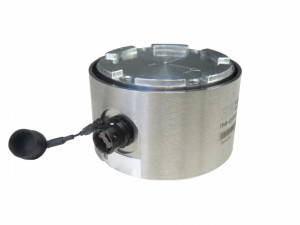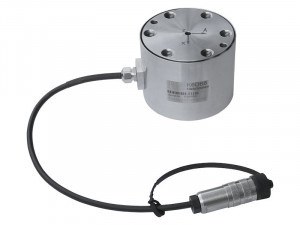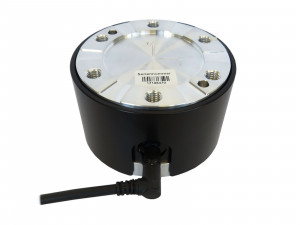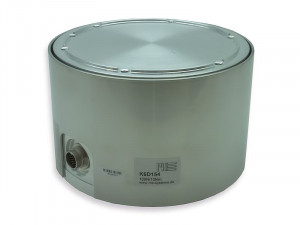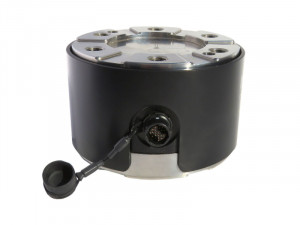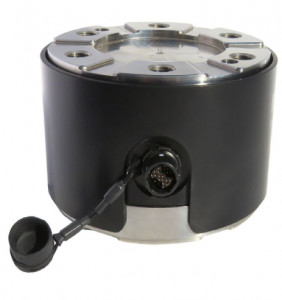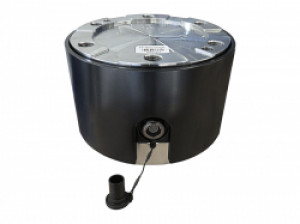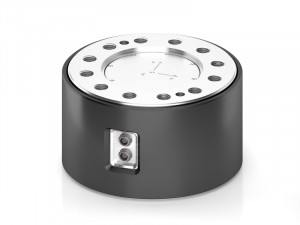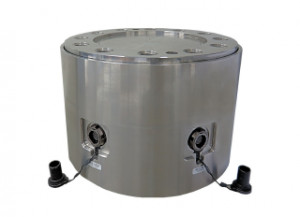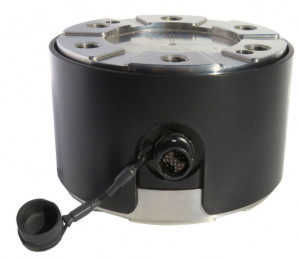Mounting of multi-component sensors
The multi-component sensor consists of a hexapod framework, which is arranged between two plates without additional joints. The sensor is (as a rule) made of one piece of high-strength aluminum (3.1354) or high-strength, ferritic stainless steel (1.4542).
For the function of the sensor, it is crucial that the end faces are not locally deformed.
A local deformation is caused, for example, by a selective application of force Fz in the center of the sensor.
The force is applied flat on the circular ring between the inner centering collar and the outer diameter. The force is applied to the trapezoidal circular segments. The recesses between the segments are not loaded.
In addition to the introduction of force on the circular ring, flatness and rigidity of the connecting flange are important parameters. High-strength aluminum or tool steel 24CrMo4 or C60 tempered or high-strength stainless steel 1.4542 should be selected as material. Plastic flanges from the 3D printer are unsuitable!
An untightened screw can cause measurement errors of the order of 10% or more.
The tolerance for the flatness of the flanges is 0.02mm.
Table 1 gives guidelines for the thickness of the connection flanges and the recommended tightening torque. If the recommended tightening torque exceeds the rated torque of the sensor, then torque should not be passed through the sensor. Instead, it should be held against the flange directly.
The screws should have a minimum strength of 8.8. From 100Nm, screws 10.9 are recommended.
Sensor Material thickness, tightening torque, screw-in depth t F6D45
20N/1Nm: 3.0 mm, M3, 1,3 Nm, t=5 mm (counterhold directly on the bolted flange)
K6D27
50N/1Nm: 3.0 mm, M2, 0,4 Nm, t=4 mm K6D40
50N/5Nm, 100N/5Nm: 5.0 mm, M5, 6 Nm, t=6 mm 200N/5Nm, 500N/20Nm: 6.0 mm, M5, 6 Nm, t=6 mm K6D80
200N/20Nm ...1kN/50Nm: 8.0 mm, M8, 20 Nm, t=9 mm 2kN/100Nm ...5kN/250Nm: 10.0 mm, M8, 30 Nm, t=9 mm K6D68
1k/20Nm ...2K/50Nm: 10.0 mm, M10, 40 Nm, t=12 mm 5k/50Nm ...10K/500Nm: 12.0 mm, M10, 60 Nm, t=12 mm K6D110
1k/100Nm ... 8k/500Nm: 14.0 mm, M10, 50Nm, t=10 mm 10k/750Nm: 14.0 mm, M10, 70 Nm, t=10 mm K6D130
1k/200Nm ... 5k/500Nm: 16.0 mm, M12, 80 Nm, t=14 mm 15k/1.2kNm: 18.0 mm, M12, 120 Nm, t=14 mm K6D150
2kN/200Nm ... 10kN/1kNm: 20.0 mm, M12, 100 Nm, t=14 mm K6D154
50N/5Nm ... 100N/10Nm: 10.0 mm, M6, 10 Nm, t=8 mm 200N/20Nm ... 500N/50Nm: 10.0 mm, M6, 14 Nm t=8mm (To save mass, recesses of 6 triangles up to 1mm wall thickness are recommended (rib structure).
K6D175
10kN/1kNm ...50kN/5kNm: 28.0 mm, M16, 250 Nm, t=24 mm K6D225
50kN/10kNm ... 200kN/20kNm: 40.0 mm, M20, 500Nm, t=23 mm
| Symmetry of the flange: When designing the flange, care should be taken that local weak points do not cause unbalanced deformation of the surface of the force sensor. | |
| Force- / Torque Introduction | |
| When introducing forces and torques, it must be ensured that the flange plates of the K6D sensor do not deform. Particularly when introducing moments, the introduction should be central and symmetrical. |
Individual outbreaks, as shown in the picture opposite, should be avoided.
Negative example for the design of a mounting flange Force- / Torque Introduction When introducing forces and torques, it must be ensured that the flange plates of the K6D sensor do not deform. Particularly when introducing moments, the introduction should be central and symmetrical.
Negative example of moment insertion Flatness of the flange plate The illustration shows a local deformation of the flange plate due to an asymmetrical introduction of a moment.
Local Deformation of sensor surface due to unsymmetrical moment insertion Symmetrical introduction The figure shows a flange for the (largely) symmetrical introduction of torques for the K6D225 sensor.
Assembly rules for K6D Sensors
High rigidity of the flange plate,
Good symmetry in the load / force transmission via the flange plate, Low deformation within the sensor mounting surface << 10 µm, If these points cannot be achieved, it is recommended to calibrate the sensor with the accessories. positive example of moment insertion Mounting the flange The assembly of all components from one side is often possible only by the design of a two-piece flange.
Example for K3D110:
Adapters for Comau SMART-5 NJ-60:
zb-k6d110_adaptation_000-a-.pdf
Flange for K6D80:
so051_001-a-.pdf
so051_002-a-.pdf
Centering
The multi-component force sensors have a centering collar. (Inside diameter 0 ... + 0.1mm oversize, 1 ... 3mm depth).
In addition, two pin holes are provided for clearance E7 / m6.
To secure the angular position, one of the following variants is recommended (depending on the manufacturing tolerances):
Use of the centering collar to secure the centering plus 1 centering pin to secure the angular position in a slot Use of 2 centering pins: in an E7 hole to secure centering, and in a slot to secure the angular position Use of 2 centering pins in two holes E7 to ensure centering and angular position ("double-fit") Use of the centering collar and use of 2 centering pins in two holes E7 ("3-fold fit") If double or triple fits are used, it is recommended to use centering pins DIN 7979 with female thread if they are to be dismounted ...
Materials
If possible, the flange should be made of the same material as the sensor: aluminum sensors with aluminum flange (about 23 μm/m/°C), steel sensors with steel flange (about 12 μm/m/°C). Otherwise, the temperature-related drift of the sensor can be adversely affected by the introduction of temperature-specific voltages.
Mounting position
The sensors can be mounted in any mounting position. As with any force sensor, care must be taken that the connection cable is assigned to the fixed shore (the non-moving flange). Otherwise, forces are applied to the sensor via the connection cable.


